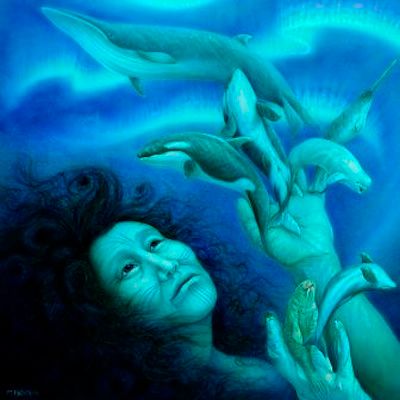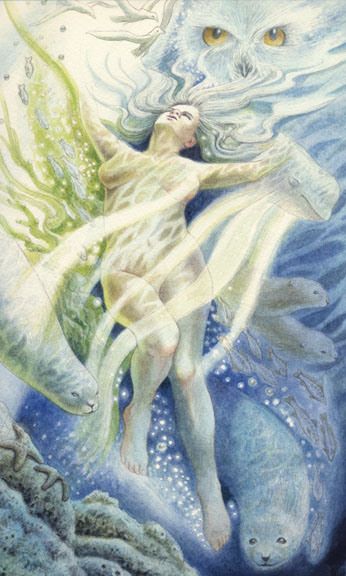 |
| Hrana Janto |
In the last semester of my B.A., I took a class on the popular writing of Indigenous writers. There, I was introduced to Ajjiit: Dark Dreams of the Ancient Arctic, a collection of short stories drawing on Inuit culture and lore. Lurking in the margins of these stories is a character who never sees the light of day: Sedna the sea goddess, the “Deep Mother,” the “greatest Agony of the deep.”
Sedna, also known as Nuliajuk and Taleelayu, is the most powerful being in Inuit mythology. She is typically depicted as a mermaid-like figure, with a woman’s body and a whale tail. However, the Taleelayu is not like the traditional mermaid. Kinngait artist Pitaloosie Saila describes her thusly: “I believe in Taleelayus -- not mermaids, the way that qalunnaat (white people) seem to think about them. Their mermaids are just beautiful creatures, sitting on top of rocks, but for us, Taleelayu is the great leader of the animals, underneath the sea.”
Sedna is certainly more than a pretty face. She rules the realm of Adlivun, the Underworld of the North. There, souls are purified in preparation for the journey to the moon, or Quidlivun, where they find their eternal rest. When Sedna is angry, she produces storms; however, she can be assuaged by a shaman descending into the deep to wash and braid her hair. When she is content, she provides the Inuit with the sea creatures on which they rely for food and oil.
There are several versions of Sedna’s origin story, all featuring a woman unwilling to bend to the will of society. In one, she is a giant with a voracious hunger that causes her to attack her parents. In another, she rejects all of her suitors only to marry a dog. In the tale that I will be discussing, she begins as an ordinary woman unhappy with her marriage prospects.
 |
| Susan Seddon Boulet |
Unfortunately, it turns out life with a bird for a husband isn’t all it’s cracked up to be. Her tent is covered with tattered fishskins, her bed is made of tough walrus hides, and she has to live on fish brought by a bunch of birds. The lesson here is intended to be something along the lines of “don’t let your pride blind you to real opportunities,” but I’m inclined to read it as something more like “marrying a bird may lead to some pretty intense culture shock.”
A year passes, and Sedna’s father comes to visit. After she tells him about her horrible living conditions, he kills the fulmar and tries to take Sedna home. Understandably, the fulmars are not impressed to find their dead companion and an empty tent where his wife ought to be, so they leave in pursuit. When they reach Sedna and her father, they create a deadly storm. Sedna’s father, in fear for his life, flings Sedna overboard in an attempt to appease the birds. When she clings to the side of the boat, he cuts off her fingers, which become whales, seals, and walruses.
Here the two versions I’m working with split off. In the one recorded by Boas, the storm dies down because the birds think that Sedna has drowned. Her father brings her back into the boat, but she pronounces herself well and truly done with him, vowing revenge. Once they arrive back home, she sics her dogs on him and they gnaw her father’s hands and feet off while he sleeps. He responds by cursing her, himself, and the dogs, all of which get swallowed by the Earth. They end up in Adlivun, where Sedna somehow becomes the ruler of the realm. I must admit that I find myself dissatisfied with this ending, as it deteriorates into nothing but a battle between two destructive personalities. The alternate ending, however, shows promise.
In many versions of the legend, Sedna sinks to the bottom of the sea following the loss of her fingers. In some mysterious way, she defies the death that usually awaits a person left to drown while bleeding copiously. Instead, she emerges from this traumatic experience as a powerful goddess, reborn in the ocean’s womb. This is a fascinating moment for a number of reasons.
The first lies in the transformation itself. The transformation from human to god is demonstrated by two important figures in Western culture: Jesus and Hercules/Heracles. The former undergoes crucifixion and the latter death by poison in order to attain godhood. Like these two towering cultural figures, Sedna achieves apotheosis through intense suffering. Unlike these men, however, she does so without a head start. Although, in some versions, she is the daughter of a god, the Sedna of Boas’ tale and many others seems to enjoy no such lineage. Instead of asserting her birthright, then, she is claiming something more.
 |
| Lisa Hunt |
Unfortunately, as much as I would love to give her the “actual strong female character” stamp of approval, the vast differences in the various versions of her story leave me at a bit of a loss for a final label. Still, however you interpret her story, Sedna is a compelling figure from a little-known but fascinating legendary tradition, and it’s well worth your time to check it out.
This was a fabulous article! I love your analysis of this deep, thought-provoking story.
ReplyDeleteThanks - this is the perfect accompaniment to a gorgeous carving of Sedna at the Winnipeg Art Gallery
ReplyDeleteThanks for this article. I came across it while researching versions of the Sedna legend for a poem I'm writing, and it's been very useful.
ReplyDeleteI didn't find Pitaloosie Saila's comment about Sedna to be descriptive of her at all, as the author's preceding comment indicates...all she says is that she believes in Taleelayus and that they're not mermaids as "white people seem to think of them". Actually, mermaids are tons more than "pretty faces" to a lot of white people and pretty much every other major culture too and it's a shame so many people think that Disney's "The Little Mermaid" is a sound basis for what they really are. They are no less intriguing and powerful than Sedna, regardless of her depiction as what is a more European-originating half-woman-half-fish form, which rather has it's true origins in Mesopotamia, i.e. the "mermaid goddess" Atargatis or Derceto. Their roles and true complexities and powers are very profound and prevalent throughout ancient history, myth and magic and shouldn't be discounted.
ReplyDeletehi love this im doing a project and it helped alot!! :)
ReplyDelete